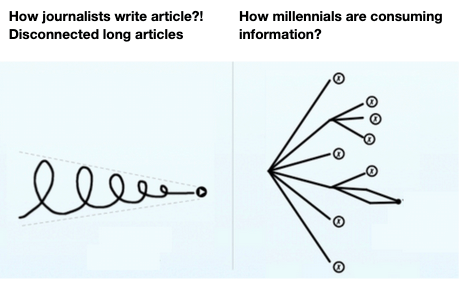
[Concept] Introducing context cards

There are some stories that capture the imagination of the public for weeks and months. In India, one such case was the Aarushi Talwar case. Internationally, the disappearance of Malaysia Airlines Flight 370 was another story that lasted for years. When writing a follow-up story, newspapers can take one of two approaches.
One could recap the context in short. However, readers who want a more detailed background of the story need to Google it and thus exit the story. Another option is to recap the context in detail. However, readers who already know about it find it to be unnecessary repetition. However, constantly recapping the same information across stories is additional writing work for desk staff that can be avoided.

Reading habits on the Internet are scattered. Most people consume information in a piecemeal fashion across platforms instead of reading one long article. Journalists like writing in long form, a legacy of print.
Turns out, big media is already trying out solutions
TheGuardian is using cards for explainers
Source: https://www.theguardian.com/politics/2017/apr/26/gina-miller-raises-300000-for-candidates-to-oppose-hard-brexit Source: https://www.theguardian.com/politics/2017/apr/26/its-going-to-be-a-bloodbath-tories-target-high-profile-labour-seats
When VOX started, one of their first products was cards

There is an entire CMS called fold.cm built around context cards

Another product using this concept is Bloomberg Lens.
Context cards are reusable pieces of information that can be used across stories to help readers recap.
What is a card?
Teaser view is a tiny card that introduces extra information to readers in a visual, yet non-intrusive way. All teaser views have a standard layout. On click of a teaser card, the teaser card expands into a deep-dive card. More material from site to serve reader’s information needs
Teaser view Expanded view
How context cards can be used
Context cards can be used in a variety of ways:
1. Story background: What is this story about? Who did what? What happened when? Get me up-to-speed. (Stories that develop over a period of time)
2. News I can use: How does this story impact my life? (my – every persona impacted as part of this story)
3. Call to action: Take action – Donate for a cause, sign a petition, email policymaker. ActionButton.org
4. Meta Context: How many such events are occurring?
5. Trivia Context: Bias of people, Organisation profiles, Laws, Bills in Parliament, ESG index of firm, etc
Example of cards
Context cards help find balance between reader experience and editorial effort
1. Accepts any kind of information: One design pattern that can hold any kind of information — sports, news, politics, stock, etc.
2. Adapts to reader’s needs:
- This content is placed where reader needs it
- Readers invoke them on-demand. Rest ignore.
- Changes form if reader expresses intent to know more
- Time and energy commitment from reader is well-defined
3. Fits into any experience: On design pattern that can fit into textual stories, photo albums, live blog, etc.
4. Take content to readers. Not readers to site: Give information to readers where they need it.
5. Produce only that content that is reusable. Define a TG and find knowledge gap for that TG within each topic.
6. Promote structured content creation
- Instead of text, content should be produced in one of the pre-defined layouts and formats.
- Reduces cognitive load for journalists.
7. Automate + Curate
- Automatically organise existing articles into topic pages.
- Auto-create structured content from APIs.
- Partner to source credible external content.
8. Works with existing workflow
- Journalists type stories on MS Word. Desk copy pastes into CMS
- Platform agnostic. Integrates with any CMS.
Reading habits on the Internet are scattered. Most people consume information in a piecemeal fashion across platforms instead of reading one long article. Make learning serendipitous with context cards.
Applying context cards to ESG index for listed companies
Educate investors about Environment Social Governance (ESG) indices to audiences coming to business sites.
Applying context cards to Gender rights
Readers are not well-informed about gender issues. News media do not do gender stories because traffic is low. Instead of asking media companies to change their business model, can we embed gender-related content in everyday stories? Constant visual reinforcement across stories can make an understanding of gender issues muscle memory. In this example, we take sexual harassment-related laws from Nyaya.in and push it into news articles.
Know your rights – 1 Know your rights – 2 Know your rights – 3
Law context card – 1 Law context card – 2 Law context card – 3 Law context card – 4

























